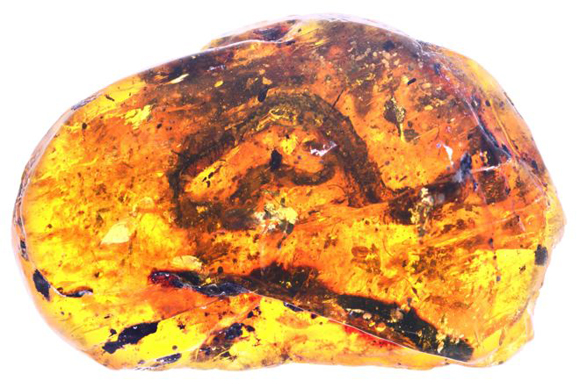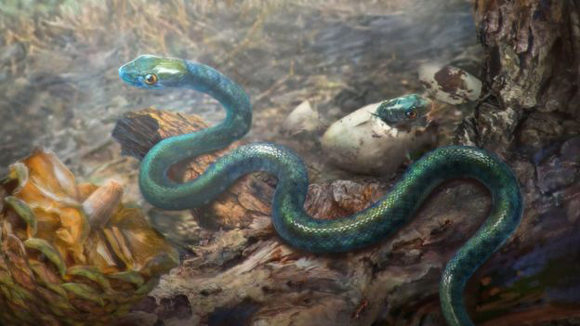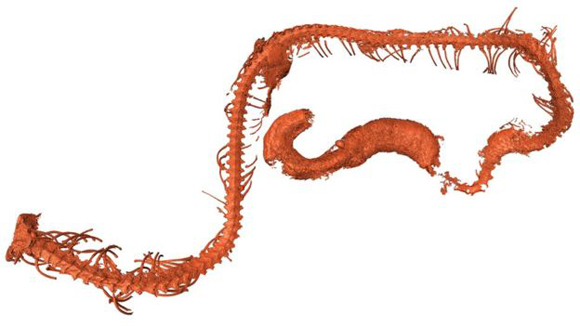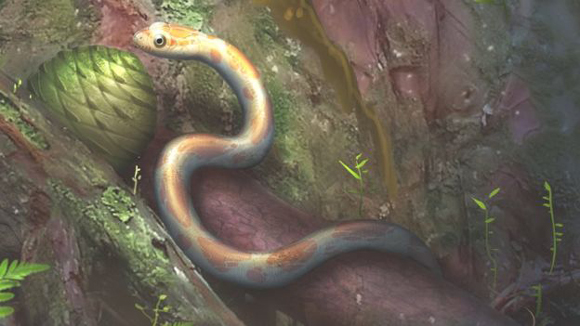Xiaophis myanmarensis – Remarkable Dawn Snake of Myanmar
Baby Snake Preserved in Amber from Myanmar
A team of international researchers including scientists from the University of Alberta, Midwestern University and the Chinese Academy of Sciences have published a paper describing the remarkable discovery of the preserved remains of a baby snake entombed in amber from Myanmar (Burma). The snake has been named Xiaophis myanmarensis.
Amber deposits from northern Myanmar are providing scientists with some amazing insights into life in a forest some 100 million years or so ago. Other amber nodules, known as burmite have revealed the preserved remains of baby birds, a dinosaur tail, frogs and an astonishing range of invertebrates and plant material. The amber is proving to be a treasure trove for palaeontologists helping them to map the biota of a Cretaceous environment.
The Polished Amber Nodule Revealing the Fossilised Remains of a Baby Snake

Picture credit: Ming Bai (Chinese Academy of Sciences)
Xiaophis myanmarensis – Dawn Snake of Myanmar
The baby snake measures around eight centimetres in length. The fossil reveals that the vertebrae are not yet fully formed and this indicates that the snake was very young when it got trapped in the sticky tree resin. The snake has been named Xiaophis myanmarensis, which means “dawn snake of Myanmar”.
The international research team, led by Dr Lida Xing (China University of Geosciences, Beijing and the Chinese Academy of Sciences) and Professor Mike Caldwell (University of Alberta), have described this discovery as a remarkable fossil find.
A Life Restoration of Xiaophis myanmarensis

Picture credit: Cheung Chung Tat
Not One Fossil Snake but Two
Although the baby snake is missing its skull, ninety-seven vertebrae have been preserved along with associated fossil ribs. The tiny reptile’s bones were analysed using a synchrotron to bombard the specimen with X-rays and plot the result. The back bone is remarkably similar to those found in neonatal snakes today. This suggests that the vertebrae of snakes have remained largely unchanged for 100 million years.
A second amber fossil was discovered, which preserves a piece of the shed skin of another, much larger snake. It is unclear whether these two fossils represent the juvenile and adult of the same species.
The Skeleton of the Baby Snake As Modelled from the Synchrotron Data

Picture credit: Ming Bai (Chinese Academy of Sciences)
Xiaophis myanmarensis – A Remarkable Fossil
The discovery of this remarkable fossil, along with the piece of shed snake skin helps palaeontologists to build a picture of the evolution of snakes and how they spread following the break-up of the super-continents during the latter stages of the Mesozoic.
Dr Palci (Flinders University) and a co-author of the scientific paper published in the journal “Science Advances” commented:
“At 100 million years old, it dates back to the age of the dinosaurs, well before snakes started to differentiate into modern groups. This Asian fossil helps shed light on how primitive snakes dispersed from the southern to the northern continents. Although found in the Northern Hemisphere, it strongly resembles South American snakes that lived at the time.”
An Illustration of the Second Snake Specimen (Life Reconstruction)

Picture credit: Yi Liu
During the Jurassic, the region that we now know as Myanmar was joined to Antarctica, Australia, Africa and South America, forming the giant, southern super-continent of Gondwana. As the Mesozoic progressed so this landmass began to split apart, Myanmar separated from Gondwana and drifted north, eventually colliding with Asia.
This is the first baby snake fossil from the Mesozoic ever found and it, along with other remarkable specimens preserved in amber from Myanmar (burmite), are providing scientists with a unique window into the Late Cretaceous world.
Visit the Everything Dinosaur website: Everything Dinosaur.

